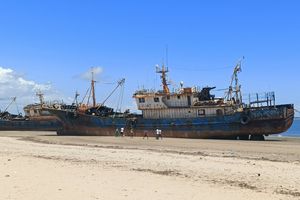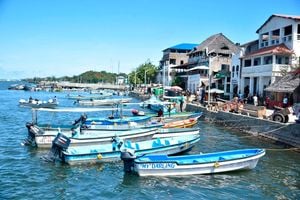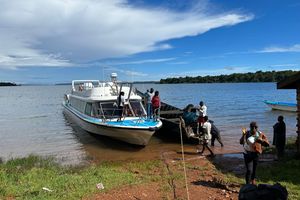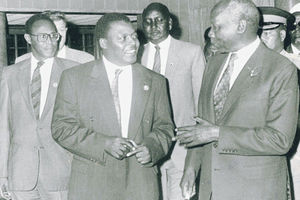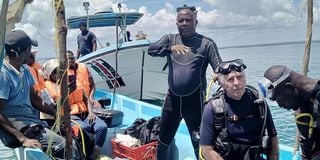
National Museum of Kenya Coast Regional Head of Archaeology Department Dr Ceaser Bita (standing, in diving gears) and Prof Fillipe Castro (seated) prepare to dive in the Indian Ocean during the ongoing research on the wreckage of ship believed to have been owned by ancient sailor Vasco Da Gama.
When a group of fishermen from Ngomeni in Malindi, Kilifi county, started spotting strange objects in the sea on their daily fishing spree 17 years ago, they became concerned about where the items were coming from.
Some of the fishermen picked up the objects and carried them to their homes and later reported these incidents to the National Museums of Kenya (NMK) office in Malindi town.
Their report led to the discovery of a ship wreckage that has spent centuries on the floor of the Indian Ocean.
The revelations by the fishermen was the beginning of the journey by the NMK and two researchers from the US and Portugal, to embark on a mission to research the Portuguese ship believed to be one of the 16 vessels belonging to ancient sailor, Vasco Da Gama.
According to NMK Coast Regional Head of Archaeology Department, Ceaser Bita, the vessel sank in the 16th Century.
Lately, Ngomeni village has been a beehive of activity as the team of researchers gears up to retrieve more historical artefacts from the wreckage.
Dr Bita said after confirming the ship underwater, NMK, together with the National Museum of China and the University of the King, commenced an exercise to research the vessel and retrieved a few items from 2010 to 2014.
“We published information in one of the international journals, and it attracted international scholars' interest in researching the ship,” he said.
The team of researchers embarked on a diving spree with the help of locals.
“We have been diving for the past two weeks now to research this wreckage to know how big it is, why it sank, where it was coming from, and what it was carrying,” he said in an interview earlier this week.
According to Dr Bita, it has been established that Vasco Da Gama used the ships for his businesses along the East African coastline.
“It was among the 16 ships owned by Vasco Da Gama that he used during the last moments of his business using routes in the Indian Ocean.”
“There is no ship belonging to Vasco Da Gama that has ever been discovered anywhere when he was alive or now for people to understand how it looked,” he said.
Dr Bita said among the things they retrieved were pieces of broken pots believed to have been used by the sailors, pieces of wood, and a wooden frame that proved it was a ship.
They also recovered a piece of ivory, and the pieces of pots were found to be from different countries, including India, Bangladesh, Vietnam, Ukraine and Thailand.
Some pieces of metal, firewood and a rope were also retrieved.
“All the items we have retrieved have shown us that indeed the vessel was involved in big business,” Dr Bita said.
The local community also surrendered some of the items they had collected before to the National Museum of Kenya.
Dr Bita stated that the presence of the ship has revealed that there is a lot of underground history that is yet to be unearthed linking the East African Coast with other parts of the world that need to be researched.
He said the findings were a more concrete proof that the Indian Ocean on the East African Coast has been on active business for over 2,000 years.
“This is an indication that the Indian Ocean was famous for trade from a long time ago, from 50 years BC until the 16th Century, and this adds to the rich history that we are yet to finish researching underwater,” he said.
The researchers are now aiming to establish a unique museum in the country for Kenya's underwater heritage in Ngomeni.
The National Museum of Kenya and the team of researchers will construct a model of the ship on land in Rasi village, Ngomeni, as they continue to preserve the ship's wreckage inside the Indian Ocean.
Apart from preserving history, this is intended to diversify tourism attractions in the Coast region as well as open up opportunities for underwater tourism.
Dr Gary Philbrick from the US, the sole sponsor of the research and excavation exercise, said the wreckage was about 20 by 40 metres.
“It is a significantly larger wreckage than many people could have imagined; when you see the size of the timbers, frames, ribs, planking on the bottom, it is a large structure,” he said.
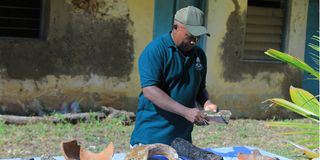
National Museum of Kenya Coast Regional Head of Archaeology Department Dr Ceaser Bita displays some of the items recovered from the wreckage of a ship believed to have been owned by ancient sailor Vasco Da Gama.
Dr Philbrick said his interest in exploring the Vasco Da Gama ship came from the fact that he has life experience in the ocean from when he was five years old.
“My curiosity has been enormous that when I am older and acquired enough wealth (I want) to be able to support these things and for me, it is an incredible experience to observe for myself and to share with friends and community that explores their underwater world.
"It is a huge world, (if) we know about watching space by far then we need to know what is in the water,” he said.
He said the community was involved directly in the excavation mission, and they were able to witness it first-hand.
“They are understanding what is in the water, understand and realise there is something spectacular to protect for the history, and the next generations and Ngomeni are going to thrive in the coming years through tourism,” he said.
Prof Filipe Castro, an Archeologist from Portugal said they would continue excavating the wreckage to establish more about it. Prof Castro came to Kenya in March to try to join Dr Bita in researching the vessel.
“We are assessing the site and excavating to understand how the structure of the ship is and what the situation is. How many artefacts are still there, and how much would it fully take to excavate them,” he said.
Prof Castro acknowledged that the site is amazing.
“The excavation is very amazing. I wasn’t expecting a lot but this is twice as better as I would expect as far as the area is and the quality of the work,” he said.
“It is a privilege to excavate a shipwreck like this, in a beautiful place such as Ngomeni and to work with a wonderful team including local divers, professional, competent and dedicated,” he added.
He said they had seen part of the hull which was extensive.
“There is no doubt that this shipwreck was Portuguese as established by Dr Bita. We are counting on the support of the government, the National Museum of Kenya, local authorities and the local population because this is a community Archeology project," he explained.
Prof Castro stated that in the late 15th Century and early 16th Century, the Europeans started building large ocean-going vessels.
The Chinese had done it before in the 15th Century, and the Europeans took the big trading vessels from the Mediterranean and made these ocean-going ships.
“They are very sophisticated machines, steady and strong, and big. But we were not prepared for the size. I don’t know how big this ship was; in the archives, we found out that the Portuguese lost eight ships on the Coast of Kenya around this place,” he said.
NMK Coast Regional Deputy Director Athman Hussein said they wanted to establish why the ship sank.
“Up to now, we believe the ship could have caught fire, and the crew and those on board had to swim out of the waters to the villages in Ngomeni,” Mr Hussein said.
He said the NMK recognised the ship excavation as a very important project because of the two museums, on land and underwater.
“For the first time in history, we have discovered a second boat. The first one being the one that sank at Fort Jesus in Mombasa and now Ngomeni,” he said.
Mr Hussein said several factors could not allow the NMK to start working on the ship wreckage immediately after it was discovered.
The NMK is training the community on diving skills on how to identify underwater objects.
“It is one way NMK is moving in the community to sensitise them on how to identify a historical heritage, the importance of conserving it and using it to benefit economically by earning a living,” he added.
Mr Alphonse Dena from Rasi village in Ngomeni said they welcomed the research and applauded the National Museum of Kenya for directly engaging the community and equipping them with diving skills.
“This is a great milestone for Ngomeni youth because the project is an eye opener and a way to improve our livelihoods,” he said.

